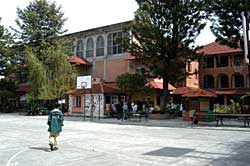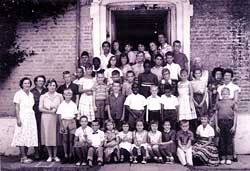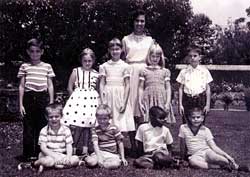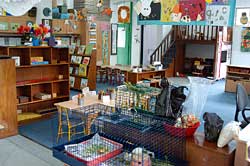 The playground at Lincoln School in Rabi Bhawan is a microcosm of today's world. Students from Nepal to Canada, Israel to Eritrea mingle comfortably in one multi-lingual, ethnic, national and cultural mass.
The playground at Lincoln School in Rabi Bhawan is a microcosm of today's world. Students from Nepal to Canada, Israel to Eritrea mingle comfortably in one multi-lingual, ethnic, national and cultural mass. Diversity is now a key point at Lincoln, although when it first started in 1954 as Lincoln Cooperative School it consisted of eight students, all the children of Americans working in Nepal. In the 50 years that followed, Lincoln has grown from its humble beginnings into a full-fledged international school, with about 30 teachers and a 240-strong student body that includes Nepalis and children of expatriates from all over the world. Typically, over 35 nationalities are represented, and currently 20 percent of the students are Nepalis, 30 percent are North American, 28 percent are from across Europe and the remaining 22 percent from various other nations.
Over the years, many Nepali parents have chosen this international school because of Lincoln's educational approach, which focusses on developing creative and critical thinking skills. Many claim that this move has helped their children gain an edge in life, especially within Nepal. The parent of a former Nepali student explains, "In a traditional Nepali education, the teachers mould the student. At Lincoln, they unfold. The teachers guide the student in discovering his true self." Bhaskar Koirala, who graduated from Lincoln in 1994, says, "I really developed a more 'textured' view of people of different nationalities and cultures. I also met some truly remarkable people, including my wife, Juna Maya Pandey. I was fascinated by the ease with which students from different countries got along with one another."
"The greatest thing about Lincoln is the individuality, attitude and diversity that each person, be they student, teacher, parent or custodian, brings to Lincoln," says Bhaju Shrestha, a library assistant who has been working in Lincoln for 26 years.
 Barbara Butterworth, the school's director, agrees. "Most of the teachers at Lincoln have been here for at least six or seven years, while some have been here more than 20. Our caring atmosphere for the student, for each other and for Nepal makes people want to stay."
Barbara Butterworth, the school's director, agrees. "Most of the teachers at Lincoln have been here for at least six or seven years, while some have been here more than 20. Our caring atmosphere for the student, for each other and for Nepal makes people want to stay." This atmosphere obviously creates strong bonds, and when Lincoln School celebrated its 50th anniversary last weekend alumni and former staff flew in to Kathmandu from around the globe. Among the guests was John Ritter, who served as director at Lincoln from 1977 to 1980 and is currently the director of an international school in Laos.
Many alumni and former staff were amazed by the changes in the school's infrastructure, especially those who remember most of today's compound as plain fields. In fact, a small wall is all that is left of the early Lincoln School building. "That old building has been torn down now," comments Ritter, "all that remains from it is the wooden floor, which was reused as the stage for the theatre."
 A new building, completed in 2000, houses most of the classrooms and computer and science labs. The computer network of over a hundred workstations accessible to all staff and students came as a surprise for those who remembered the school's pre-PC days.
A new building, completed in 2000, houses most of the classrooms and computer and science labs. The computer network of over a hundred workstations accessible to all staff and students came as a surprise for those who remembered the school's pre-PC days. Other developments are less tangible, but evident nonetheless. Lincoln is a member of the South Asian International School Association (SAISA), and in the 15 years since joining, Lincoln students have participated in and hosted numerous sporting events, music competitions and choir competitions. Currently, volleyball and swimming are the hot topics as the school's teams recently returned from tournaments in India and Sri Lanka. "These events are just amazing," says a 10th grader. "Not only do we get to represent Nepal in other countries, but we get to travel and learn about other cultures too."
"The main issues that the school faces are the same as the ones that any Nepali school faces," says Suzie Burns, who has been a teacher at Lincoln School for the past 25 years. "Chakka jams, strikes and educational bandas affect us just like they affect any other school. We then have to worry about how to make up for lost time and, like everybody else, resort to classes on Saturdays and Sundays."
 Students however, have a different problem. "There is a notion that we are really pampered here," says Nina Schick, a senior at Lincoln. "Students from other schools think that our courses are easy and that nobody cares if we don't study. Boy is that wrong! The subjects here are much harder than in any other school that I've been in." Nepali students say that other Nepali kids sometimes view them differently, and seem to think that they are forgetting or ignoring their country and heritage.
Students however, have a different problem. "There is a notion that we are really pampered here," says Nina Schick, a senior at Lincoln. "Students from other schools think that our courses are easy and that nobody cares if we don't study. Boy is that wrong! The subjects here are much harder than in any other school that I've been in." Nepali students say that other Nepali kids sometimes view them differently, and seem to think that they are forgetting or ignoring their country and heritage. However, the school ensures that the students, no matter where they are from, learn about the country that they are living in. "Students learn about Nepal, and the children from kindergarten to grade five have Nepal studies," explains Kabita Pande, who teaches the subject. The curriculum focusses on Nepali culture, language and the Nepali society in a global context. This, along with other school traditions like the Leopardstown project that the primary school children work on, creating a simulated community with its own laws, elected government, shops and even taxes, are intended to make the students socially aware global citizens.
Looking back at his time as a student, Bhaskar Koirala says, "One of the drawbacks of Lincoln School 10 years ago was was the limited scope to make more sustained connections with the wider Nepali society. I imagine this has now changed for the better." Among the other Nepalis who have benefited from a Lincoln education is Ajay Jatia, who graduated in 1990 and has gone on to become the executive director of Jagdamba Cement Industry. He says the only drawback of having studied in a school with such diversity is that the alumni eventually end up scattered all over the world. Jatia has decided to make an effort to streamline the Lincoln alumni association, and says, "The golden jubilee is just the kick start we need."


